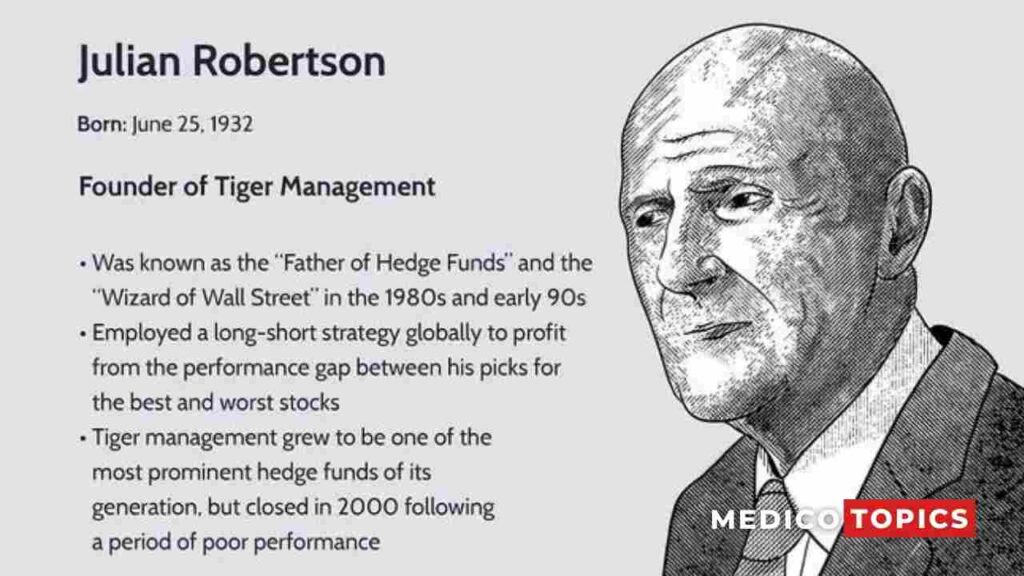
Julian Robertson, Hedge-Fund Guru to ‘Tiger Cubs,’ Passes at the age of 90. Let’s see how he died and Billionaire Julian Robertson cause of death
How did he die?
Julian Robertson, the billionaire Tiger Management founder who became one of his generation’s most successful hedge-fund managers and a mentor to a wave of investors known as Tiger Cubs, has died.
He was died at the age of 90. He died at his home in Manhattan from cardiac complications, according to Fraser Seitel, a longtime spokesman for Robertson.
Julian Robertson’s cause of death
He suffered from a prolonged cardiac complication and heart problems were his cause of death.
The North Carolina-born investor started New York-based Tiger Management in 1980 with $8.8 million. He was 48 at the time, relatively old to be launching his firm.
By mid-1998, assets had soared to about $22 billion on the back of annual returns averaging 32%, earning him a reputation on par with those of industry peers George Soros and Michael Steinhardt.
Who is Julian Hart Robertson?
Julian Hart Robertson Jr. KNZM, an American billionaire hedge fund manager and philanthropist, lived from June 25, 1932, to August 23, 2022.
Robertson made investments in other hedge funds, primarily in ones that were operated by ex-workers of Tiger Management, his now-defunct hedge fund firm.
Around 50 of the most prestigious hedge funds in the world are managed by the so-called Tiger cubs, including Stephen Mandel’s Lone Pine, Andreas Halvorsen’s Viking, Rob Citrone’s Discovery Capital Management, Philippe Laffont’s Coatue Management, Lee Ainslie’s Maverick Capital, and Chase Coleman’s Tiger Global Management.
He took the Giving Pledge and signed it. One of the first hedge funds, Tiger Management, was formed by Robertson.

Early life and Schooling
Robertson is the son of Blanche Spencer, formerly Julian Hart Robertson Sr., a textile manufacturing executive.
He earned diplomas from the University of North Carolina in Chapel Hill in 1955 and Episcopal High School in 1951, respectively.
He was accepted into the Zeta Psi fraternity while attending Chapel Hill.
Moreover, he then served in the U.S. Navy as an officer until 1957.
Robertson relocated to New York City after leaving the Navy, where he spent some time working as a stockbroker for Kidder, Peabody & Co.
Before leaving Kidder to relocate with his family to New Zealand for a year so that he could write a novel, he eventually served as the head of the company’s asset management division (Webster Securities).
Tiger Management was established in 1980 by Robertson upon his return to the United States.
His Outstanding Achievements
While in New Zealand, Robertson hatched the idea for a new fund. He launched Tiger Management, one of the first hedge funds, upon his return to New York in 1980.
Robertson used initial investments believed to be approximately $8 million. Tiger’s assets grew to $22 billion over the next two decades.
The fund’s success is credited to Robertson’s ability to identify investment opportunities within the framework of a global macro trading strategy.
Robertson often employed a long-short strategy, loading up on the best stocks he could find while shorting those he thought the worst.5
Julian Robertson is credited with being the first major hedge funder, and his success spawned numerous successful hedge fund investors.
Robertson was also known for his avoidance of tech investments during the buildup of internet stocks in the late 1990s.
This avoidance was a double-edged sword for Tiger Management. The fund performed well during the eventual collapse of the tech bubble but suffered from a drain of capital as investors took their money to Silicon Valley.
An additional stressor came from a significant investment in U.S. Airways, which did not go well for Robertson.6 U.S. Airways would file for bankruptcy guard in 2002 and again in 2004.
Robertson liquidated the Tiger Management fund in 2000 following poor performance.8 He wrote that Tiger’s success had been based on a rational approach to valuation and trading.
This strategy had proven less effective alongside the irrational growth of internet stocks.9
In the years that followed, Robertson focused his efforts on mentoring and investing with a slate of up-and-coming hedge fund managers known as the “Tiger Cubs.”
Prominent members of this group contain John Griffin of Blue Ridge Capital, Ole Andreas Halvorsen of Viking Global, Chase Coleman of Tiger Global Management, and Steve Mandel, formerly of Lone Pine Capital.10111213
His Wealth and Charity
Robertson has been engaged in philanthropic activities since turning away from fund management.
He established scholarships at his alma mater and Duke University and committed to The Giving Pledge, a campaign founded by Bill Gates and Warren Buffet.14
Robertson has also been active in New Zealand, purchasing a handful of luxury lodges throughout the country.
15Forbes report that Robertson has donated $1.3 billion to charitable causes.
He is an active philanthropist who has donated over $1 billion in charitable funds.
Among them include environmental protection, charter schools, and medical research. As of Dec. 31, 2021, at the age of 89, he is worth $4.8 billion.
Tiger Foundation
Strachman claimed that Robertson’s propensity to refer to people as “Tiger” when he couldn’t recall their names was the source of the name Tiger.
The company was in charge of $1 billion in assets by 1991.
Robertson managed the Tiger Foundation to aid low-income New Yorkers and their families in addition to his hedge fund profession.
According to its website, since it was founded in 1989, it has given more than $250 million in grants to support educational institutions, programs for job training, and early childhood development.
Robertson changed Tiger Management after liquidating his hedge fund into a company that invested in a lot of new managers by providing them with funds in exchange for a portion of their revenues.
He had finished his difficult task of handling customer money.
I didn’t want to have that in my obituary.
In an interview with the Australian Financial Review in 2013, Robertson said, “He died receiving a quote on the yen.
Personal life
Robertson owned wineries and several golf resorts in New Zealand, where he spent a portion of every year.
Josie, formerly Josephine Tucker, the spouse of Robertson, passed away from breast cancer in 2010.
They had three sons: Spencer, who worked at the Tiger Foundation before starting to Pave charter schools, Julian III, also known as Jay, who oversaw his father’s properties in New Zealand, and Alexander, who rose to the position of president of Tiger’s seeding company.
Julian Robertson Net Worth:
$4.4 Billion
Julian Robertson Net Worth: Julian Robertson, Jr. is an American hedge fund executive who has a net worth of $4.4 billion. Julian earned his fortune as the creator of Tiger Management Corp., an investment company.
Julian Hart Robertson, Jr. was born on June 25, 1932, in Salisbury, North Carolina. After graduating from the University of North Carolina, he moved to New York and started to work as a stockbroker for Kidder, Peabody & Co.
Keep reading,
How did superyacht sink in Italian coast? What happened?
Olivia Pratt-Korbel killed: What happened to the 9 year old girl?
Follow us on Twitter to get instant notifications on the latest news.
Lavanya (Senior Editor) is a full-time content writer with almost 5 years of experience and a part-time teacher. She joined Medico Topics on the Breaking News trainee scheme in 2022 and now works on MedicoTopics.com. As a lifelong learner, She is constantly curious about learning new things and passionate about sharing knowledge with people through her writing and teaching.
